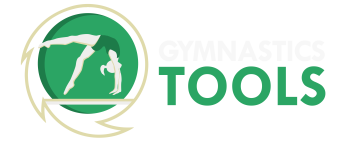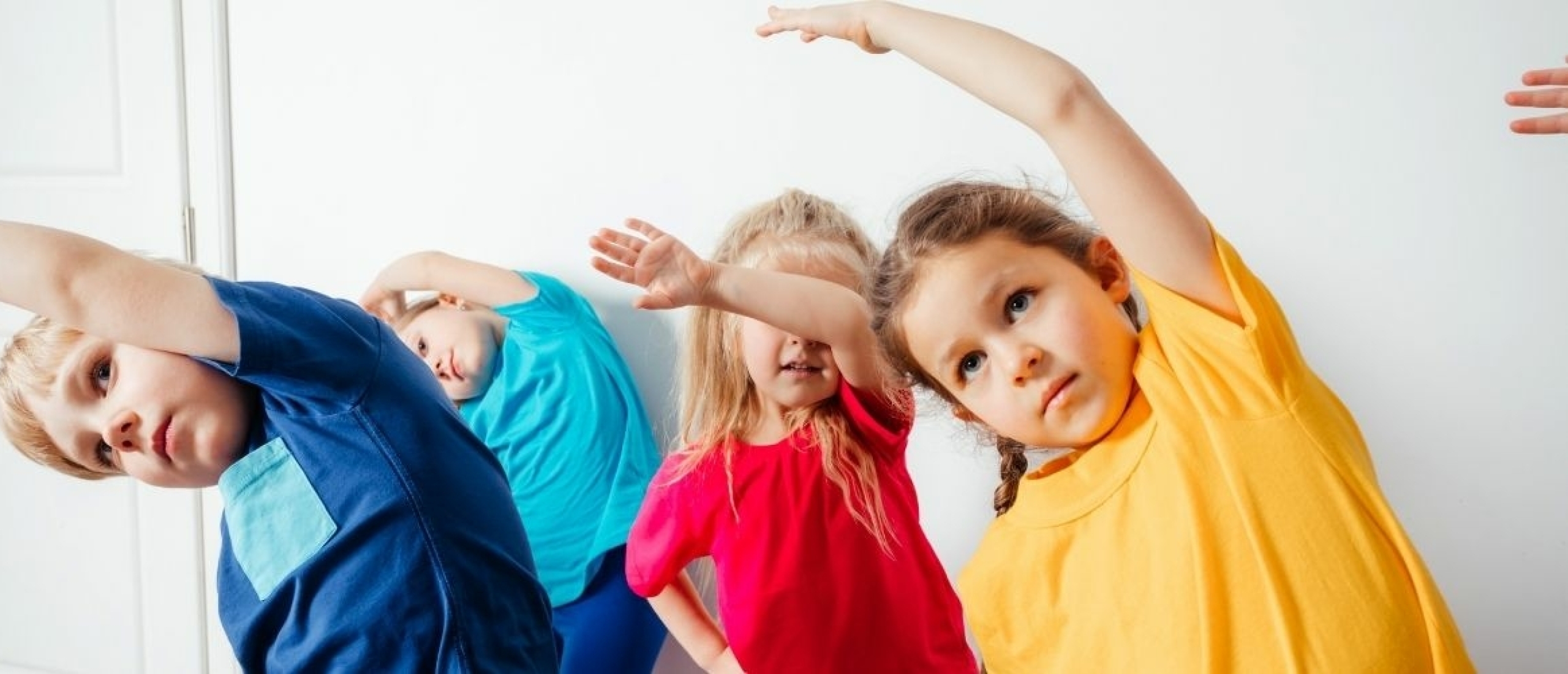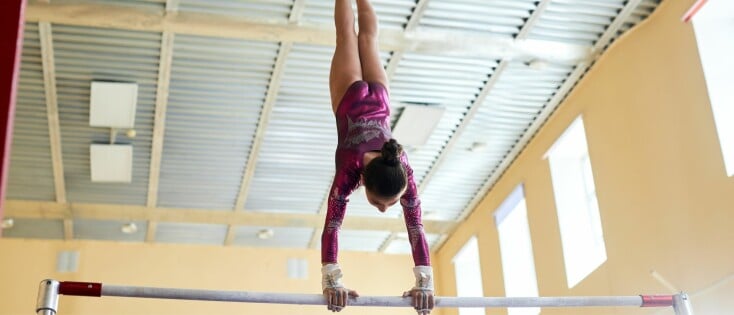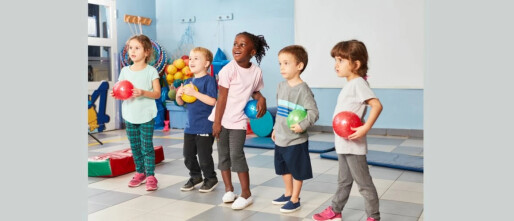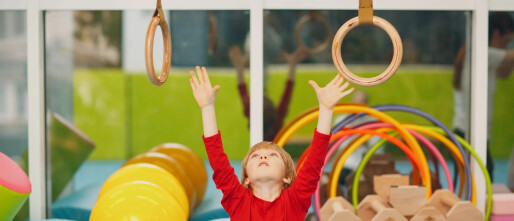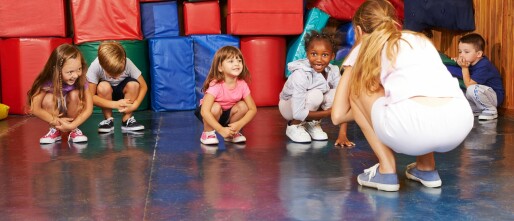Giving kindergarten gymnastics lessons. Perhaps not everyone can do it. It is a lesson group that often needs a different approach than other lesson groups. You need to be able to empathise with toddlers and pre-schoolers. And the age difference is often enormous during gymnastics lessons. That is why many teachers wonder which kindergarten exercises are suitable to offer during the kindergarten lessons. In this article we show which kindergarten exercises you can offer, and what you should pay attention to during the kindergarten lessons.
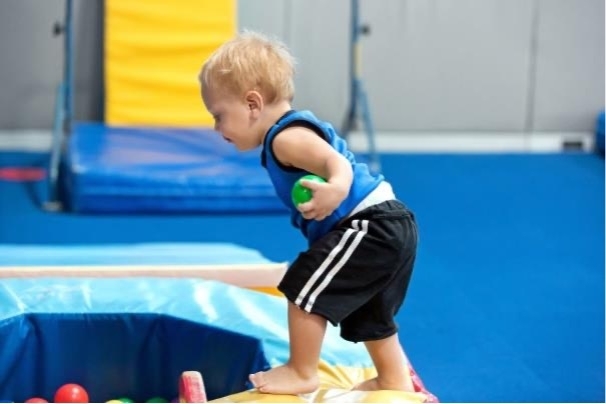
The importance of kindergarten
Perhaps one of the most important and versatile lesson groups in your club: the toddlers! The basis for good motor development is laid at a very young age. The younger a person is with movement, the more impact movement has on all areas of development. Through a lot of versatile and varied movement, children learn how to use their bodies. And in doing so, become and feel motorically competent.
The importance of kindergarten lessons. Children and exercise. The media have been full of it in recent years. And not without reason. More and more children do not exercise enough in everyday life. The rise of social media, television and game consoles means that children would rather stay at home than be active. Fortunately, there is an increasing awareness of the importance of exercise. Exercise at a young age ensures good motor development in children.
Kindergym lessons offer a wide range of basic motor forms of movement. It enables the child to become motorically competent in many areas. Children who have attended kindergarten gymnastics classes will move flexibly and dexterously in later life. In this blog we give you ten important basic forms of movement. If you offer these movements in your toddler gym class on a weekly basis, you will be preparing the kids for the future!
Basic forms of exercise
Before we go into detail about the basic exercises for your nursery school class, let us first tell you a little bit about the basic forms of movement. Offering the basic forms of movement as a total package ensures that the children in your nursery school class are optimally developed motor skills. There are more than 20 basic forms of movement in kindergarten. Some of them you will surely know, such as ducking and rolling. The basic forms 'working with resistance' or 'swinging stylistically' may not sound familiar to you. Because the most well-known basic forms are also the most important ones, we will discuss the top 10 in this blog. Here they are:
- climbing and scrambling
- rolls
- plunge
- deep jump
- swing
- waving
- throwing / aiming / catching
- jumping
- balancing
- hopscotch / gallop
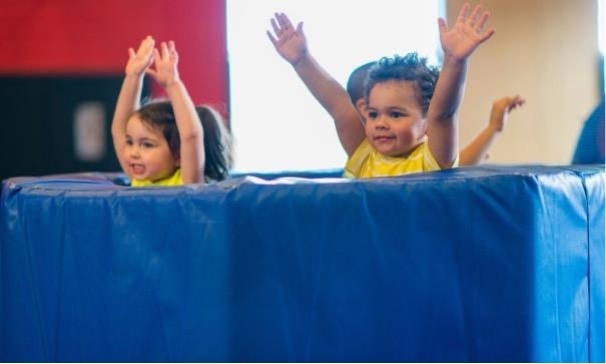
Now that you have an overview of 10 important basic forms of movement for your kindergarten lesson, we will explain each movement in more detail. We will explain exactly how the movement works, and we will give you some fun ideas for practising the movement.
Climbing and scrambling
Climbing and clambering are very popular in the kindergarten lessons of young children. There is a wall rack in every gymnasium. This means that climbing and scrambling can be offered in every lesson. What not everyone knows: there is a difference between climbing and scrambling! How was it again? What is climbing, and when are the children climbing? Climbing takes place on equipment that already tells the children, as it were, how to get on the equipment. A kind of constraint is created, as it were. In a situation of coercion, the movement arrangement is set up in such a way that the desired movement execution is, as it were, automatically triggered. In a wall rack or on a ladder, it is logical that you climb up the rungs of the ladder.
Scrambling, on the other hand, is where the child decides how to get on the apparatus. An example of scrambling in your gym class is climbing up on a thick mat standing upright against the wall rack. Or clambering on top of a high cupboard, over which a long mat has been placed.
Rolls
A very well-known movement in kindergarten: rolling. Maybe you now immediately think of making the head roll. However, rolling comes in many different forms, and can be offered in many different ways. With toddlers, it is wise not to start with the somersault immediately. By introducing children to rolling in a simple manner during the kindergarten lesson, they can learn the movement quickly and easily. The somersault is often a very difficult movement for a toddler to perform. Because the head is still relatively large compared to the rest of the body, it is difficult for the toddler to roll over it. Rolling around the length axis is a good alternative for this. In nursery gymnastics we talk about a pancake roll or a pencil roll.
Below you will find a number of practice rolls. From a simple introduction to rolling, to the 'real' rollover.
Dive
The movement form tumbling is often offered when the children are familiar with rolling. You can also offer tumbling in different ways in your nursery school lessons. The most well-known is diving on a horizontal bar. But what about diving in the ropes, on the trapeze bar and in the rings?
Many children find diving very exciting at the beginning. They also have to perform various actions while diving. Not only do they have to turn their body around its width, but they also have to remember to hold on to the device they are sitting on.
The latter sometimes causes problems. Children who are hanging upside down and suddenly experience fear are often inclined to let go of their hands. It is therefore very important to help them to dive in the right way. Have a look at some nice exercises for diving in your kindergarten lesson!
Jumping into your kindergarten class
Number four in the list: deep jumping. In your kindergarten gym class, you may already be offering more deep jumping than you initially think. Deep jumping involves jumping from an elevation to a lower surface. Examples are jumping from a cupboard onto a thick mat. But also jumping from a bench onto the ground. The height you jump from depends on the level and age of the children. In the kindergarten lessons it is fun for the children when small materials are used during the deep jump. This makes the exercise just that bit more fun and challenging. Examples of this are:
- Deep jump and landing in a hoop
- deep jumping with a beanbag between the knees
- throw a ball through a basket during the deep jump
- deep jumping and landing on foot mats
- deep jumping with a beanbag on your head
Challenge
In these ways you challenge the children just a little bit more. Deep jumping does not only have to be done with a straight jump. Let the children do a spread jump, a squat jump or a half turn while jumping off a block! Watch these videos for inspiration for your own kindergarten lesson:
Swinging and swaying
We continue with two basic forms, which in my view belong together: swinging and swaying. Always a success in your kindergarten lessons. Swinging and swerving gives the children a great insight into height, speed and distance. An important basic form to offer in your nursery school lessons.
Swinging can be done in various ways. Think of swinging in the ropes, sitting with your legs in the rings, on a trapeze stop, on a big family swing, and so on. Swinging is also done on these apparatuses. When swinging, the children hold the rings with their hands, of course. Rope swinging can be done from one bench to another, and increases the children's grip strength enormously. With trapeze swinging and ring swinging, among other things, the children also practise the parrot grip. With this grip, the thumb is on the stick. In this way, the child can hold on to the apparatus in a safe manner.
Throwing, aiming and catching
These basic forms are often offered in game form in the nursery school lessons. Throwing / aiming / catching is an important part of a good kindergarten lesson. It develops the ball skills of the children. Of course, this basic form does not only have to be practised with a ball. Various small materials can be used to offer practice forms. Below is a list of ideas:
- throw beer mats into a cabinet section
- throwing small balls into an upside-down pawn
- Throwing and catching a ball
- throw bags of stones in an upside-down umbrella
- aiming small balls with a hockey stick into the pits of the gymnastics poles.
Jumping during kindergarten
The first thing the children ask me when they enter the kindergarten class: 'Teacher, are we going to jump on the trampoline today? :-) A trampoline is magical for most children. This piece of equipment is often used in my kindergarten lessons.
However, there are many other ways of offering the basic form of jumping in the lesson. Jumping does not necessarily have to be done from a springy apparatus. It can also be done over mats, on a bench or from cabinet to cabinet. If you are working in flow form, it is fun to have the children jump from one piece of equipment to another. Think of jumping on steps that are in a course, or jumping through a row of hoops in a row. The possibilities of jumping in kindergarten are endless!
Balancing
An often exciting basic form of movement in the nursery gym class: balancing. Having a good balance can bring you many benefits in everyday life. Not only during sport, but also during normal activities. A good example is cycling. Children who are introduced to balance exercises at a young age will also be able to ride a bike relatively quickly. Balancing in a toddler gymnastics class does not only have to be done on the well-known 'gymnastics beam'. Balancing can be done on various apparatuses. The use of small materials is also applicable in this basic form.
Balancing can be practised in a stationary position, or during movement. An example of stationary balancing is standing on one foot on a cube. You could also, for example, stand on the cube and step through a hoop at the same time.
Moving balancing can be done by walking over a bench, a bench upside down, a beam, blocks in a course, over a rope, over a ladder lying on the ground, and over balls wedged in a cabinet part. By making the object on which the child is balancing move, the challenge becomes even greater. Below we show you some examples of balancing in a kindergarten lesson!
Hopping, skipping and galloping
We finish with the basic forms hopscotch, skip and gallop. All three of these movements are often difficult to teach to toddlers in kindergarten. Mastering one basic form, often helps to learn the other. The canter, also called chassee or connecting pass, is actually a half unfinished hop.
If a toddler has mastered the canter, it is often easy to make the step to the skip. The balance exercises and jumping exercises shown in the films above are also an important prerequisite for learning hopscotch and skip. By offering these basic forms in a varied way, the children are optimally stimulated to master the skills.
Development in the kindergarten class
At first glance, it is gross motor skills that are most prominent in nursery school gymnastics. Think of walking, jumping, hopscotching, shooting a ball, etc. But also the fine motor skills that are trained in the daily life of the child, for example by cutting, making a sandwich, writing, can certainly be trained in the gymnastics lessons. To be able to offer these kinds of exercises, a kindergarten teacher needs to have a creative mind.
Kindergarten exercises for fine motor skills
Kindergarten exercises for gross motor skills
Offering kindergarten exercises in different forms of organisation
There are many ways to offer kindergarten exercises in the gymnastics class. One form of organisation has different advantages than the other.
Offer kindergarten exercises in flow form
When working in flow form, the children in the nursery class do a pre-specified round of gymnastics. The children do each task once. Then they continue directly, via the indicated route, to the next task. The direction of the gymnastics round can be indicated. This can be done using hoops, blocks, steps, ropes, small mats, etc.
Advantages of working in current form:
- children are 'forced' to go through each exercise
- high teaching intensity
- clear for the teacher
Disadvantages of working in current form:
- risk of traffic jams
- less control of the correct execution of the exercise
Offering kindergarten exercises in group form
The name says it all. When working in groups, the children are divided into a number of groups, after which each group does one exercise. The group stays with an exercise for a certain time and thus performs it several times. After a certain time, they will switch to the next assignment.
Working in groups is a form of organisation that was often used in the past, especially in the gymnastics and competition groups. Often only 4 or 5 exercises/pieces are trained on. Nowadays, teachers are taught to offer many small forms of exercises in which an element, for example a handstand, is chopped up into pieces. The whole hall is then covered with small steps from the different phases of the handstand.
Advantages of working in groups:
- much structure for the children, only need to remember one task
- clear for the teacher
Disadvantages of working in groups:
- lower lesson intensity
- less challenge
- less diversity
Offering kindergarten exercises during a free lesson - with instructions
In a free lesson with instructions, the pre-schoolers can partly determine their own lesson. All the apparatuses that are available may be used. The teacher gives an assignment or instruction for each piece of equipment. Children can decide for themselves what they are going to practise. But also how long they stay with an assignment, and whether they want to do all the assignments.
Advantages of a free lesson with instruction:
- Preschoolers have control over their own lesson. The pleasure is increased by allowing them to do their most fun task more often or just
- children can exercise at their own pace
- children can exercise at their own level
Disadvantages of a free lesson with instruction:
- less learning
- Less overview for the teacher
- the chance that there will be toddlers who will do nothing
Offering kindergarten exercises during a free lesson - independent
In an independent lesson, the toddlers largely determine their own lesson. Only the equipment arrangement is predetermined. All the apparatus that are ready may be used. Children can decide for themselves what they are going to practise. But also how long they will stay with a task, and above all, how they will carry it out. Especially the latter is often inspiring and surprising to the teachers. Toddlers often use a device in a completely different way than you had initially intended!
Advantages of a free lesson independently:
- Preschoolers have control over their own lesson. This increases their enjoyment by allowing them to do their best task more often or just
- children can exercise at their own pace and level
- creativity and inventiveness of the toddler is stimulated.
Disadvantages of a free lesson independently:
- less learning
- Less overview for the teacher
- the chance that there will be toddlers who will do nothing
Methodical teaching with differentiation
Methodical teaching means building up certain profile elements or a basic form of movement in steps. Let's take a handstand as an example. When teaching the handstand, you don't immediately have the child do a handstand, but you first practise small parts of this element. For example, you let them walk in a wheelbarrow, to practise supporting themselves. If the child is lying on an elevation, let them 'slide' down and then swing their legs up to simulate the handstand. Practising all these small steps will ensure that the child eventually has the physical conditions to do a handstand.
Often, children from the age of 6 are taught methodically within the club, and not the pre-schoolers. However, it is very well possible to teach the target group of pre-schoolers in this way. All basic forms of movement can be trained methodically with fun exercises.
Top roll exercises for kindergarten
Avoid using the same exercises over and over again in your kindergarten lessons. Download our free rollover checklist with more than 80 different methodical exercises on video to teach the rollover.
Balancing kindergarten exercises
Crawling kindergarten exercises
Finally
Hopefully this blog has given you enough inspiration to offer a fun and varied kindergarten lesson. Our mission at Gymnastics Tools is to inspire and stimulate as many teachers as possible to offer fun, effective and varied gymnastics classes. With our platform, we hope to help not only the trainers, but especially the children in their development of movement. On our toddler platform we have about 1000 methodical videos of all the basic forms of movement. We have also designed 20 game cards to quickly prepare a fun game for your kindergarten lessons.
Which kindergarten exercises do you use yourself in your kindergarten classes? Let us know in the comments!
